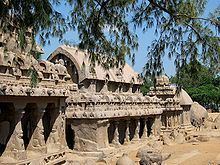Reign 600–630 CE Died 630 AD Parents Simhavishnu Children Narasimhavarman I | ||
 | ||
Similar Narasimhavarman I, Simhavishnu, Pulakeshin II | ||
Mahendravarma I (Tamil: மகேந்திரவர்மன் 600–630 CE) was a Pallava king who ruled the Northern regions of what forms present-day Tamil Nadu in India in the early 7th century. He was the son of Simhavishnu, who defeated the Kalabhras and re-established the Pallava kingdom.
Contents
During his reign, the Chalukya king Pulakeshin II attacked the Pallava kingdom. The Pallavas fought a series of wars in the northern Vengi region, before Mahendravarma decimated his chief enemies at Pullalur (according to Pallava grants at Kuram, kasakudi and tadantottam). Although Mahendravarma saved his capital, he lost the northern provinces to Pulakeshin. Tamil literature flourished under his rule, with the rise in popularity of Tevaram written by Appar and Sambandhar. He himself was the author of the play Mattavilasa Prahasana and another play called Bhagavadajjuka.
Mahendravarma was succeeded to the throne by his more famous son Narasimhavarman I in 630 CE. At last he defeated Pulakeshin II and ransacked the Chalukyan capital city Vatapi (also known as Badami).
Patronage of arts and architecture
Mahendravarma was a great patron of letters and architecture. He was the pioneer of Rock-cut Architecture amongst the Pallavas. In the inscription at the Mandagapattu rock-cut temple, it is claimed that the temple was built without wood, brick, mortar or metal. The five-celled cave temple at Pallavaram was also built during his reign as was the Kokarneswarar Temple, Thirukokarnam of Pudukottai, Tamil Nadu.
Fine examples of his rock-cut temples can been witnessed at Mahabalipuram, (Satyagirinathar and Satyagirishwarar twin temples), Siyamangalam (the Siva temple Avanibhajana Pallaveswaram) in North Arcot district and the upper rock-cut temple at Trichy. Apart from the Siva temples, Mahendravarma also excavated a few Vishnu cave temples, the Mahendravishnugrha at Mahendravadi, and the Ranganatha temple both at Singavaram both in present-day North Arcot district.
He was also the author of the play Mattavilasa Prahasana, a farce concerning Buddhist and Saiva ascetics. He is also claimed to be the author of another play called Bhagavadajjuka,. This is evident by the inscriptions found at Mamandur cave shrines (near Kanchipuram - this place is mentioned as Dusi Mamandur to avoid confusions with other places by the same name). However, there is an alternate view that attributes this play to Bodhayana.
Religion
Mahendravarma was initially a patron of the Jain faith, but he converted into the Saiva faith under the influence of the Saiva saint Appar. According to Dhivyacharitam a Sanskrit work on life of Alwars written in 12th century, Yatotkara perumal (mahavishnu), enshrined in Kancheepuram left the city along with his great devotee Thirumazhisai Alwar, because the Vaishnava Alwar faced tough persecution and exilement from the king who had at least temporarily come under the influence of Jainism.
